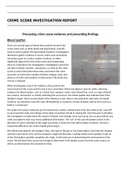CRIME SCENE INVESTIGATION REPORT

Processing crime scene evidence and presenting findings
Blood spatter
There are several types of blood that could be found at the
crime scene such as dried blood and liquid blood. A sterile
swab is used to gather the liquid blood evidence. Investigators
attempt to gather evidence in its full, which may necessitate
removing a part of a wall or carpet, furniture, or other
significant objects from the crime scene and transporting
them to a laboratory for investigation. Investigators search for
any flow of blood, transfer, consistency, or voids at the crime
scene to assist them determine when and where the crime
occurred, as well as the number of blows, weapon used, and
posture of victim and assailant to determine if the death was
instant or delayed.
When investigators search for evidence, they examine the
environment of the scene and the way it was committed. What investigators look for while collecting
evidence for blood spatter, such as a hand, foot, weapon, voids, and a blood flow, such as a sign of blood
loss volume, movement, or activity following the occurrence. The blood spatter also indicates that if the
droplet is larger, there is more blood; if the distance is vast, there is less spherical; and lastly, the blood
travels in one direction (cast-off). Cast-off bloodstain is caused by a series of blows with an item such as a
knife or a restaurant.
The action of trying to swing the gun for blunt force creates a blood traces from the victim to be "cast-off"
to all around the walls and ceilings; these types of analysis will aid in solving the crime because it will allow
the investigators to determine the volume of blood, even though none was found; we can also look for any
voids and patterns that may reveal additional information. The 'tail' of the cast-off splatter points in the
direction of travel, therefore if the angle was steep, it means the tail will be longer; however, the tail is
frequently difficult to see as the droplet grows larger.
We will be searching for the weapon's flow, the type of the gun or the sharp object, how hard the weapon
and how many times it hit, and the weapon's angle and direction. Looking closely at the splatter to get all
of the information possible completes the study. It will assist you in determining the environment of the
crime. We will draw lines across each image to determine if the spatter comes from the same source, as
well as to demonstrate the movement's flow.
, If there is a huge droplet, it indicates that the
crime scene was performed with a brusque item
since it is a blunt force trauma.
To demonstrate the point of source, the bulk of
spatter appears to come from the same contact
point. However, if we look carefully at the second
image, we can see some drops that are not from
the same spot and are at a different angle.
The droplets forming an arc in the third image
are cast-off from an "upswing" of an item that
already contains blood. Blood will have already
been present on the item, indicating that many
strikes occurred. The arc also appears to roll to
the right, indicating that the crime was
perpetrated by a right-handed person.
The yellow lines in the fourth figure represent the
main point of source for most of the spatter,
while the blue lines show spatter from other
directions, indicating many strikes.
The "tails" on these droplets in the last shot can
prove that it is a multiple blow, despite the fact
that it is far more difficult to discern, and the
evidence is even more subjective.
The evidence in the images definitely implies that many hits were
employed, based on the tails found with the droplets, the flow of the
swings and how part of the blood emerges from a different area, and
the obvious sign of the arc. Because of the way the arc swings, it is
also likely that the perpetrator was right-handed. It is also quite likely
that the crime was perpetrated with a blunt weapon, as the blood
splatter pattern clearly indicates that the attack was caused by blunt
force injuries.
This evidence is a little qualitative in that, it can provide conclusive
evidence without using figures, but it is still very subjective. This is
because it all comes down to how you look at the splatter and how
you figure out what happened after the initial impact. This tells me a
lot about the attack since it indicates that it was not planned. Because
the victim was hit in the head with a blunt object that was most likely




